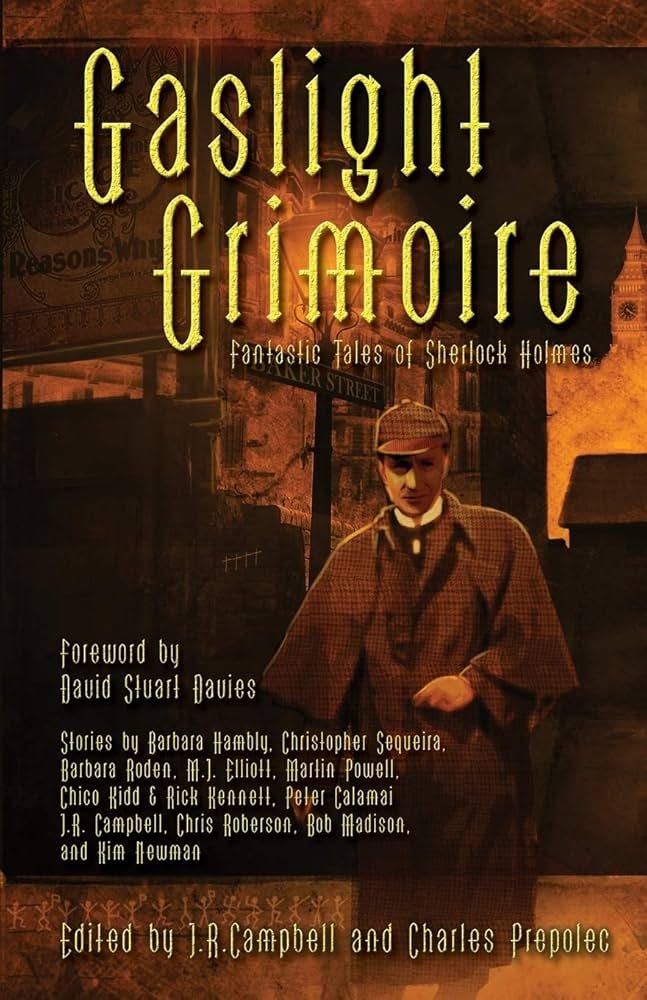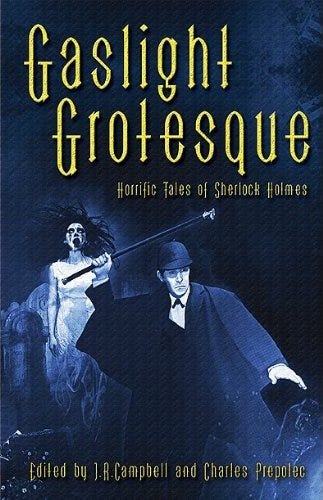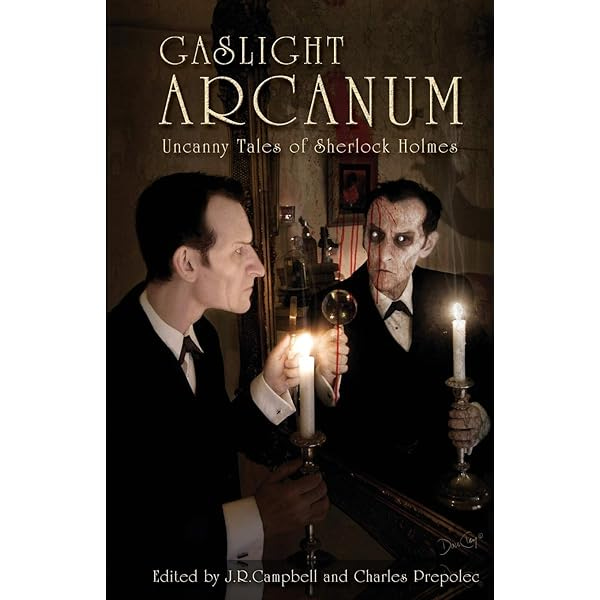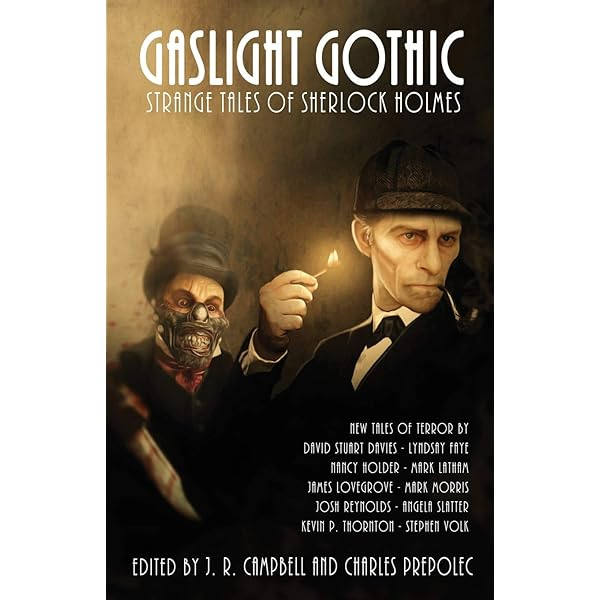THE ALCHEMY OF HOLMES AND THE WEIRD PRODUCES GOLD
At the heart of the four Gaslight anthologies published by Edge Books lies a creative alchemy—the marriage of Sherlock Holmes’ rational, forensic mind with supernatural, gothic, and fantastical elements. This combination invites readers to reconsider Holmes not merely as a paragon of Victorian detective fiction, but as a figure who, when placed against boundaries of the impossible, illuminates those boundaries through his method, skepticism, and observation. Each anthology, approaching variation in tone—from fantasy to horror, uncanny to gothic—invites distinct yet complementary readings of Holmes and his world.
In Gaslight Grimoire: Fantastic Tales of Sherlock Holmes, the Great Detective steps into realms suffused with magic, myth, and the marvelous. Each story posits a scenario where Holmes’ logical framework confronts—and often engages with—fantastic forces such as faeries, sorcery, and mythic creatures. The charm here lies in how these tales preserve Holmes’ rational core even in a world that seems to repudiate reason. Readers witness a figure who does not dismiss magic but seeks to understand it, applying his forensic and observational techniques to phenomena beyond the mundane. The interplay between wonder and intellect creates a narrative tension that delights—Holmes as the detective-adventurer at the edge of myth, unafraid to probe the impossibility, yet unfailing in deduction.
The second anthology in the series, Gaslight Grotesque: Nightmare Tales of Sherlock Holmes, turns the lamp of Holmes’ reason toward horror’s darkest corners. In these disturbing vignettes of nightmare, madness, and grotesque transformations, Holmes is both investigator and bulwark against existential dread. The stories often feature body horror, psychological disintegration, or uncanny monstrosities that defy explanation. What makes this collection compelling is Holmes’ stoic resolve in the face of unconscionable horrors. The rational mind, however bent, refuses to break—it becomes a mirror reflecting our own worst fears—that the universe harbors chaos beneath the veneer of order. Here, Holmes is not the solver of puzzles so much as a witness to the crushing weight of uncanny terror—and sometimes, even he cannot restore equilibrium.
Gaslight Arcanum: Uncanny Tales of Sherlock pulls back from the excesses of the prior anthology to occupy a transition terrain to stories that are uncanny rather than outright supernatural or horrifically grotesque. This uncanny landscape—perhaps best described as the familiar rendered strange—is perfect for Holmes, whose keen eye unravels subtle shifts and latent anomalies. The cases in this anthology involve objects that defy logic, echoes of past crimes returning unexpectedly, or laws of nature just slightly askew. Here Holmes’ intellectual rigor resonates strongly. He approaches the eerie with precision, peeling back layers until the strange makes sense—or at least until the boundary between sense and irrationality is clarified. This collection emphasizes uncanny resonance and psychological depth, exploring how even the smallest deviation from the norm can unsettle the fabric of Victorian order.
Finally, Gaslight Gothic: Strange Tales of Sherlock Holmes immerses Holmes in stories rich with brooding atmosphere, taking place in gothic estates shrouded in mist, whispers from beyond the grave, ancestral curses, and perils inherent in old stones. Unlike outright occult threats, the gothic here is about atmosphere and suggestion—hauntings that may or may not be spectral, and fears that arise as much from setting as from substance. Holmes’ investigations peel away layers of superstition, revealing human motivations—madness, grief, obsession—all concealed under gothic trappings. This brings Holmes back to his roots as the expositors of irrational dread turn out to be resolutely human—not necessarily supernatural. The tension between belief in ghosts and the persisting clarity of Holmes’ logic invites reflection on how environment and myth can distort perception, and how reason can restore, yet not entirely dissolve, the power of gothic suggestion.
While each anthology casts Holmes in a distinct light—fantasy, horror, uncanny, gothic—they collectively chart a journey through speculative fiction’s modes, refracted through Holmes’ analytic mind.
Each volume sets Holmes against phenomena that exceed straight forensic explanation. Whether fantastic or horrible, uncanny or atmospheric, the core theme is the intrusion of the inexplicable in which Holmes must engage with the Impossible. In every case, Holmes remains grounded. His skepticism, his empirical methods, his calm under pressure—all remain intact even when confronted with phenomena that resist rational frameworks.
Grimoire sparks wonder, Grotesque evokes dread, Arcanum unsettles with subtle shifts, and Gothic enthralls with mood and suggestion. Together, they harness a full emotional and aesthetic range. Each story invites questioning of what we choose to believe, and how belief shifts when confronted with the uncanny. Holmes acts as both guide and foil to that unsettling drift.
These anthologies reimagine Sherlock Holmes not simply as a detective, but as a versatile archetype—the rational explorer of the weird. By positioning Holmes at the threshold of the supernatural, horror, and uncanny, the collections expand the possibilities of detective fiction. Holmes does more than solve—we watch him hold the boundary between order and chaos. In that boundary, readers glimpse the enduring allure of Holmes. not in his capacity to restore calm, but in the way he demonstrates that the human mind—alert, skeptical, bold—can still confront the strange with dignity, even if not always with complete victory.
Paul Bishop is the author of fifteen novels, including the award winning Lie Catchers. He is also the editor of 52 Weeks 52 Sherlock Holmes Novels—a multi-author compendium of essays regarding fifty-two of the best Sherlockian pastiches plus much more—Available on Amazon or from Genius Books...






